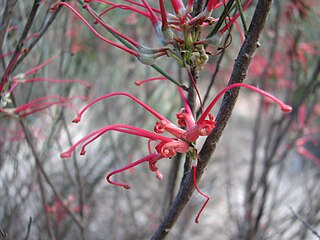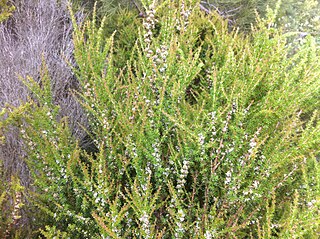
Agonis is a genus in the plant family Myrtaceae. All are endemic to Western Australia, growing near the coast in the south west.

Agonis flexuosa is a species of tree that grows in the south west of Western Australia. It is easily the most common of the Agonis species, and is one of the most recognisable trees of Western Australia, being commonly grown in parks and on road verges in Perth.

Taxandria juniperina commonly known as wattie, native cedar, Warren River cedar or juniper myrtle is a species of tree that grows in the south west corner of Western Australia. This plant was previously classified as Agonis juniperina but is now part of the genus Taxandria. The Noongar peoples know the tree as watti.

Taxandria is a group of plants in the family Myrtaceae described as a genus in 2007. The entire genus is endemic to Western Australia, growing near the coast in the South West corner of the State.

The Donnelly River is a river in the South West of Western Australia. Its main tributaries are Barlee Brook and Carey Brook. The river runs primarily through state forest reserves, although 25 private landholdings are situated along the length of the river. Clearing of the catchment area is estimated at 20% with the land mostly being used for viticulture, horticulture, dairy, grazing and tourism.

Grevillea sarissa, the wheel grevillea, is a shrub which is native to South Australia and Western Australia. It grows to between 0.6 and 3.5 metres in height and produces yellow, red or pink flowers between August and December in its native range.

Taxandria marginata is a species of shrub that grows in the south west corner of Western Australia. This plant was previously classified as Agonis marginata but was reclassified by Wheeler and Marchant into the new genus Taxandria in a 2007 revision.

Paragonis grandiflora is a plant species, endemic to the Southwest of Western Australia.

Petrophile longifolia, commonly known as the long-leaved cone bush is a shrub which is native to the south west of Western Australia, growing between the city of Albany and the Stirling Range.
Persoonia leucopogon is a species of flowering plant in the family Proteaceae and is endemic to Western Australia. It is an erect to low-lying shrub with branchlets that are densely hairy when young, narrow oblong to narrow elliptic leaves and yellow or greenish yellow flowers borne singly or in groups of up to four on a rachis up to 2 mm (0.079 in) long.
Verticordia helmsii is a flowering plant in the myrtle family, Myrtaceae and is endemic to the south-west of Western Australia. It is a shrub with most of its leaves clustered on short side branches and with small groups of scented creamish-white flowers in small groups along the branches.

Darwinia wittwerorum, commonly known as Wittwer's darwinia, is a plant in the myrtle family Myrtaceae and is endemic to a small area in Western Australia. An erect, spindly shrub with fine leaves and hanging groups of flowers surrounded by leaf-like bracts, it is one of the darwinias known as mountain bells.
Agonis baxteri is a shrub that is native to Western Australia.
Taxandria angustifolia is a species of tree that grows on the south coast of Western Australia. This plant was previously classified as Agonis angustifolia but is now part of the Taxandria genus.

Taxandria parviceps, commonly known as tea tree, is a shrub species that grows on the south west coast of Western Australia. This plant was previously classified as Agonis parviceps but is now part of the Taxandria genus.

Taxandria spathulata is a shrub species that grows along the southern coast of Western Australia. This plant was previously classified as Agonis spathulata but is now part of the Taxandria genus.

Taxandria linearifolia, also known as the swamp peppermint or the coarse teatree, is a small tree or shrub species that grows along south west coastal areas of Western Australia. This plant was previously classified as Agonis linearifolia but is now part of the Taxandria genus.
Taxandria floribunda is a small tree or shrub species that is endemic to an area in southern Western Australia. This plant was previously classified as Agonis floribunda but is now part of the Taxandria genus.
Taxandria fragrans is a shrub species that is endemic to an area in south western Western Australia.

Taxandria inundata is a species of shrub in the Myrtaceae family that is endemic to an area along the south western coast of Western Australia.












